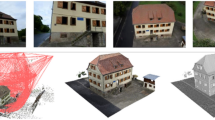Abstract
An important component of spatial data quality is the imprecision resulting from the resolution at which data are represented. Current research on topics such as spatial data integration and generalization needs to be well-founded on a theory of multi-resolution. This paper provides a formal framework for treating the notion of resolution and multi-resolution in geographic spaces. It goes further to develop an approach to reasoning with imprecision about spatial entities and relationships resulting from finite resolution representations. The approach is similar to aspects of rough and fuzzy set theories. The paper concludes by providing the beginnings of a geometry of vague spatial entities and relationships.
Similar content being viewed by others
References
B.L. Clarke. “A calculus of individuals based on ‘connection’,” Notre Dame Journal of Formal Logic, Vol. 22:204–218, 1981.
B.L. Clarke. “Individuals and points,” Notre Dame Journal of Formal Logic, Vol. 26:61–75, 1985.
A.G. Cohn and N.M. Gotts. “The ‘egg-yolk’ representation of regions with indeterminate boundaries,” in P. Burrough, and A. Frank (Eds.), Geographic Objects with Indeterminate Boundaries, Taylor and Francis: London, 171–187, 1996.
H. Couclelis. “Towards an operation typology of geographic entities with ill-defined boundaries,” in P. Burrough and A. Frank (Eds.), Geographic Objects with Indeterminate Boundaries, Taylor and Francis: London, 45–55, 1996.
Z. Cui, A.G. Cohn, and D.A. Randell. “Qualitative and topological relationships in spatial databases,” in D. Abel, B.C. Ooi (Eds.), Advances in Spatial Databases, Proceedings of SSD'93, Singapore, Lecture Notes in Computer Science 692, Springer: Berlin, 296–315, 1993.
B.A. Davey and H.A. Priestley. Introduction to Lattices and Order, Cambridge University Press: Cambridge, 1990.
T.J. Davis and C.P. Keller. “Modelling uncertainty in natural resource analysis using fuzzy sets and Monte Carlo simulation: slope stability prediction,” Int. Jour. of GIS, Vol. 11-5:409–434, 1997.
M. Erwig and M. Schneider. “Vague regions.” In Proceedings of the 5th Int. Symp. in Spatial Databases (SSD'97), Lecture Notes in Computer Science 1262, Springer: Berlin, 298–320, 1997.
J. Euzenat. “An algebraic approach to granularity in qualitative time and space representation.” Proc. Int. Joint Conference on AI, ACM Publications: Montreal CA, 894–900, 1995.
P. Fisher. “The pixel: a snare and a delusion,” Int. Jour. Remote Sensing, Vol. 18-3:679–685, 1997.
L. de Floriani, P. Marzano, and E. Puppo. “Hierarchical terrain models: survey and formalization,” In Proceedings SAC' 94, Phoenix, AR, 323–327, 1994.
M.F. Goodchild. “Data models and data quality: problems and prospects, ” in M.F. Goodchild, B.O. Parks, and L.T. Steyaert (Eds.), Visualization in Geographical Information Systems, John Wiley: New York, 141–149, 1993.
R.H. Güting and M. Schneider. “Realms: A foundation for spatial data types in database systems,” in D. Abel, B.C. Ooi (Eds.), Advances in Spatial Databases, Proceedings of SSD'93, Singapore,Lecture Notes in Computer Science 692, Springer-Verlag: Berlin, Germany, 14–35, 1993.
G.J. Hunter and M.F. Goodchild. “Dealing with error in spatial databases: A simple case study,” Photogrammetric Engineering and Remote Sensing, Vol. 61-5:529–537, 1995.
Y. Leung. “On the imprecision of boundaries,” Geographical Analysis, Vol. 19:125–151, 1987.
D.M. Mark and F. Csillag. “The nature of boundaries on ‘area-class’ maps,” Cartographica, Vol. 26:65–77, 1989.
S. Parsons. “Current approaches to handling imperfect information in data and knowledge bases,” IEEE Transactions on Knowledge and Data Engineering, Vol. 8-3:353–372, 1996.
Z. Pawlak. “Rough sets,” Int. Journal of Inf. and Comp. Sci., Vol. 11-5:341–356, 1982.
Z. Pawlak. Rough Sets-Theoretical Aspects of Resoning about Data, Kluwer, 1991.
Z. Pawlak. “Hard and soft sets,” in V.S. Alagar, S. Bergler, and F.Q. Dong (Eds.), Proceedings of RSSC'94, The Third International Conference on Rough Sets and Soft Computing, San Jose State University: San Jose, CA, 1993.
G. Shafer. A Mathematical Theory of Evidence. Princeton University Press: New Jersey, 1976.
P. Simons, Parts. A Study in Ontology. Clarendon Press: Oxford, 1987.
B. Smith. “Mereotopology-A theory of parts and boundaries,” Data and Knowledge Engineering, Vol. 20:287–303, 1996.
W.R. Tobler. “Application of image processing techniques to map processing,” in Proc. 1 st Int. Symp. on Spatial Data Handling, Universität Zurich-Irchel, Zurich Vol. 1:140–144, 1984.
F. Wang and G. Brent Hall. “Fuzzy representation of geographical boundaries in GIS,” Int. Jour. of GIS Vol. 10-5:573–590, 1996.
G.J. Williams. “Templates for spatial reasoning in responsive geographical information systems,” Int. Jour. of GIS, Vol. 9-2:117–131, 1995.
L.A. Zadeh. “Fuzzy sets,” Information and Control, Vol. 8:338–353, 1965.
L.A. Zadeh. “Fuzzy logic,” IEEE Computer, Vol. 21:83–93, 1988.
Author information
Authors and Affiliations
Rights and permissions
About this article
Cite this article
Worboys, M. Imprecision in Finite Resolution Spatial Data. GeoInformatica 2, 257–279 (1998). https://doi.org/10.1023/A:1009769705164
Issue Date:
DOI: https://doi.org/10.1023/A:1009769705164




